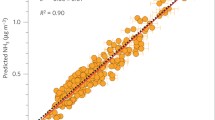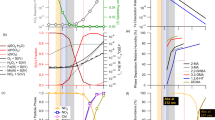Abstract
Particle acidity affects aerosol concentrations, chemical composition, toxicity and nutrient bioavailability. We present a summary of thermodynamic analysis of comprehensive observations of ambient aerosol collected over the US and E.Mediterranean to understand the levels and drivers of aerosol pH. We find that acidic aerosol in the fine mode is ubiquitous, with levels that range between 0 and 2 throughout most of the data examined. The strong acidity is largely from the large difference in volatility between sulfate (the main acidic compound, which resides completely in the aerosol phase) and ammonia (the main neutralizing agent, which partitions between aerosol and gas-phase). This counterintuitive, but thermodynamically consistent finding explains why aerosol acidity in the southeastern United States has not decreased over the last decades, despite a 70% reduction in sulfates and a constant ammonia background. We then demonstrate that evaluation of model-predicted pH is critical for model predictions of semi-volatile species, e.g., nitrate.
Access provided by CONRICYT-eBooks. Download conference paper PDF
Similar content being viewed by others
Keywords
1 Acidic Fine Mode Aerosol Is Ubiquitous
Particle acidity affects aerosol concentrations, chemical composition, toxicity and nutrient bioavailability. Aerosol acidity depends on particle composition, concentration, humidity levels, and temperature. Sulfate is the primary strong acid found in the fine mode and is neutralized throughout most of the atmosphere by volatile gas phase ammonia; regionally, non-volatile cations found in seasalt and dust (such as K, Na, Ca and Mg) also neutralize sulfate. Understanding the levels and drivers of acidity as a function of particle size, location and time is critical for understanding many aerosol processes that depend on pH.
In situ particle pH measurement is not possible for complex ambient aerosol, and so-called “pH proxies” (cation-anion molar ratios, ion balances) are largely inaccurate for determining pH (Guo et al. 2015; Hennigan et al. 2015; Guo et al. 2016; Weber et al. 2016). Application of thermodynamic equilibrium models, such as ISORROPIA-II (Fountoukis and Nenes 2007) however yield plausible pH predictions that can largely reproduce observed aerosol liquid water content and semi-volatile partitioning of NH3, HNO3 and HCl (Guo et al. 2015, 2016, 2017; Bougiatioti et al. 2016, 2017). When applied to comprehensive observations of ambient aerosol collected over the US and E.Mediterranean, thermodynamic analysis reveals that acidic aerosol in the fine mode is ubiquitous, with levels that range between 0 and 2 throughout most of the data examined (Table 27.1). This behavior arises primarily from the large difference in volatility between sulfate, which resides exclusively in the aerosol, and ammonium which always needs to partition with the gas phase to attain equilibrium. For this reason (and as long as non-volatile cations are not present in large quantity), acidity tends to slightly increase with decreasing sulfate levels—even if total ammonia remains about constant. This highly intuitive, but thermodynamic consistent behavior, explains why aerosol acidity has not reduced over time in regions like the southeastern United States, where sulfate has decreased by 70%, but ammonia concentrations have not changed (Weber et al. 2016).
2 Importance of Aerosol pH for Model Simulations
Regional and global aerosol models are routinely used to predict aerosol formation for air quality, climate and other studies. The large uncertainty of aerosol simualtions can only be reduced if the sensitivity of predicted aerosol to emissions is correctly captured. A good representation of aerosol pH is critical for this, given that many aerosol processes and the semivolatile partitioning of compounds like nitrate and chloride can be strongly impacted by pH biases. Models are never evaluated in terms of their ability to predict pH, so we advocate strongly for such evaluations be carried out in future modeling studies—especially since aerosol pH distributions from ambient data analysis is becoming increasingly available in the literature. To illustrate the importance of pH bias, we focus on aerosol inorganic nitrate predictions—an aerosol species that historically has been very difficult to capture in models and regionally important for air quality and climate forcing.
Meskhidze et al. (2003) and Guo et al. (2016) showed that there is “window” of pH values (that depends on the temperature and the amount of liquid water, but typically between 1.5 and 3; Guo et al. 2017; Bougiatioti et al. 2017), within which aerosol inorganic nitrate concentration is susceptible to shifts and uncertainties in pH. As a consequence, aerosol nitrate concentrations can increase considerably when the pH shifts within this “window”, so that aerosol pH prediction biases may precondition the model to be positively (if pH is too high) or low (if pH is too low) biased in terms of nitrate prediction skill. When below this “pH sensitivity window”, aerosol nitrate is almost nonexistent and relatively insensitive to emissions (and pH biases); when above the window, almost all nitrate resides in the aerosol phase, and directly responds to emissions.
To demonstrate the influence of pH prediction biases, we analyze CMAQ simulations over the continental US, for “current day” (2011) emissions (Vasilakos et al. 2017; Fig. 27.1) by comparing pH predictions against the observational dataset presented in Table 27.1. pH values predicted by CMAQ agree relatively well with observations, but tend to overpredict pH during the winter. We then express the partitioning fraction, ε NO3 (i.e., molar ratio of aerosol to gas + aerosol) for nitrate on a monthly basis for the CMAQ cells over the Eastern US (white rectangle in Fig. 27.1). Given that T conditions do not change significantly over one month, most of the partitioning fraction data closely follows a “sigmoid”, that has a functional form given by Meskhidze et al. (2003) (Fig. 27.2).
CMAQ-simulated partitioning fraction for nitrate, ε NO3, against pH for the month of September (left panel) and December (right panel), with “current day” emissions (Vasilakos et al. 2017). Blue symbols represent model simulations, while the red curve corresponds to the sigmoid fit. The yellow square symbols on each subplot denote the average pH for the month and domain
Once the sigmoidal fits are obtained for each simulated month, we then determine the uncertainty in ε NO3, Δε NO3, that corresponds to a given uncertainty in aerosol pH from the sigmoids. Here, we arbitrarily pick the pH uncertainty, ΔpH, to be 0.5 units around the average pH of the month. The uncertainty in ε NO3 is then expressed as uncertainty in aerosol nitrate, by multiplying the Δε NO3 with the total monthly average nitrate (aerosol + gas) from CMAQ. The results of this analysis is shown in Fig. 27.3, which shows the uncertainty in aerosol nitrate, Δ[NO3], as a function of the pH uncertainty. From the figure it becomes clear that pH uncertainties during summertime or early fall (September) lead to minor impacts on aerosol nitrate levels, because the sensitivity of ε NO3 for the September-average pH is very low (Fig. 27.2a). Wintertime nitrate levels, however, can be quite sensitive to pH shifts (Fig. 27.2b), giving up to ~1 μg m−3 aerosol nitrate uncertainty in December for ΔpH = ± 0.5 units around the monthly average (Fig. 27.3). The regional responses can be larger, depending on where you are on the partitioning “sigmoid” (the maximum sensitivity to pH biases occurs around where ε NO3 = 0.5) and the total amount of nitrate in the gridcell.
The simulated partitioning fraction for nitrate, ε NO3, against pH with CMAQ for the month of September (left panel) and December (right panel), with 2011 emissions (Vasilakos et al. 2017). Blue symbols represent model simulations, while the red curve corresponds to the sigmoid fit. The black square symbols on each subplot denote the average pH for the month and domain
3 Conclusions
Thermodynamic analysis of ambient observations show that acidic fine mode aerosol is ubiquitous in many regions of the globe, and a consequence of the thermodynamic partitioning of the major neutralizing agent, ammonia, between the aerosol and gas phase. As a consequence, the expectation that aerosol nitrate will increase as sulfate levels drop may be unfounded for many regions of the globe. We show that aerosol pH, never evaluated in models, needs to be considered for models to correctly capture aerosol responses to precursor emissions. Otherwise, important biases in predictions (here, demonstrated for inorganic nitrate) will result if pH levels are biased in models.
References
Bougiatioti A, Nenes A, Paraskevopoulou D, Fourtziou L, Stavroulas I, Liakakou E, Myriokefalitakis S, Daskalakis N, Weber R, Gerasopoulos E, Nikolaou P, Mihalopoulos N (2017) The unappreciated effects of biomass burning on fine mode aerosol acidity, in review
Bougiatioti A, Nikolaou P, Stavroulas I, Kouvarakis G, Weber R, Nenes A, Kanakidou M, Mihalopoulos N (2016) Particle water and pH in the Eastern Mediterranean: Sources variability and implications for nutrients availability. Atmos Chem Phys 16:4579–4591. doi:10.5194/acp-16-4579-2016
Fountoukis C, Nenes A (2007) ISORROPIA II: a computationally efficient thermodynamic equilibrium model for K+-Ca2+-Mg2+-NH+ 4-Na+-SO4 2-NO3 --Cl--H2O aerosols. Atmos Chem Phys 7:4639–4659
Guo H, Xu L, Bougiatioti A, Cerully KM, Capps SL, Hite JR, Carlton AG, Lee SH, Bergin MH, Ng NL, Nenes A, Weber RJ (2015) Fine-particle water and pH in the southeastern United States. Atmos Chem Phys 15:5211–5228. doi:10.5194/acp-15-5211-2015
Guo H, Sullivan AP, Campuzano-Jost P, Schroder JC, Lopez-Hilfiker FD, Dibb JE, Jimenez JL, Thornton JA, Brown SS, Nenes A, Weber RJ (2016) Fine particle pH and the partitioning of nitric acid during winter in the northeastern United States. J Geophys Res Atmos 121(10):355–310, 376. doi:10.1002/2016jd025311
Guo H, Liu J, Froyd KD, Roberts JM, Veres PR, Hayes PL, Jimenez JL, Nenes A, Weber RJ (2017) Fine particle pH and gas-particle phase partitioning of inorganic species in Pasadena, California, during the 2010 CalNex campaign, in review
Hennigan CJ, Izumi J, Sullivan AP, Weber RJ, Nenes A (2015) A critical evaluation of proxy methods used to estimate the acidity of atmospheric particles. Atmos Chem Phys 15:2775–2790. doi:10.5194/acp-15-2775-2015
Meskhidze N, Chameides W, Nenes A, Chen G (2003) Iron mobilization in mineral dust: can anthropogenic SO2 emissions affect ocean productivity? Geophys Res Lett 30(21):2085. doi:10.1029/2003GL018035
Vasilakos P, Russell A, Nenes A (2017) Aerosol pH and its effect on nitrate over a decade (2001–2011) in the United States, in preparation
Weber RJ, Guo H, Russell AG, Nenes A (2016) High aerosol acidity despite declining atmospheric sulfate concentrations over the past 15 years. Nat Geosci 9:282–285. doi:10.1038/ngeo2665
Xu L, Middlebrook AM, Liao J, de Gouw JA, Guo H, Weber RJ, Nenes A, Lopez-Hilfiker FD, Lee BH, Thornton JA, Brock CA, Neuman JA, Nowak JB, Pollack IB, Welti A, Graus M, Warneke C, Ng NL (2016) Enhanced formation of isoprene-derived organic aerosol in sulfur-rich power plant plumes during Southeast Nexus. J Geophys Res Atmos 121(11):137–111, 153. doi:10.1002/2016jd025156
Acknowledgements
This work was supported by the Electric Power Research Institute, Phillips 66 Company, the US NSF grants AGS-0931492 and AGS-0802237, the European Union (European Social Fund—ESF) and Greek national funds through the Operational Program “Education and Lifelong Learning” of the National Strategic Reference Framework (NSRF)—Research Funding Program ARISTEIA I—PANOPLY, US EPA STAR grant R835410, and NOAA CPO Award NA10OAR4310102.
Author information
Authors and Affiliations
Corresponding author
Editor information
Editors and Affiliations
Rights and permissions
Copyright information
© 2018 Springer International Publishing AG
About this paper
Cite this paper
Nenes, A. et al. (2018). High Aerosol Acidity Despite Declining Atmospheric Sulfate Concentrations: Lessons from Observations and Implications for Models. In: Mensink, C., Kallos, G. (eds) Air Pollution Modeling and its Application XXV. ITM 2016. Springer Proceedings in Complexity. Springer, Cham. https://doi.org/10.1007/978-3-319-57645-9_27
Download citation
DOI: https://doi.org/10.1007/978-3-319-57645-9_27
Published:
Publisher Name: Springer, Cham
Print ISBN: 978-3-319-57644-2
Online ISBN: 978-3-319-57645-9
eBook Packages: Earth and Environmental ScienceEarth and Environmental Science (R0)







